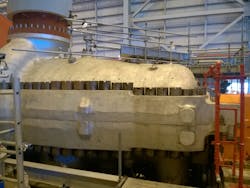Condition monitoring is the process of collecting, interpreting and monitoring different operating parameters such as vibration, temperature, flow, acoustic emissions and performance data of machineries in order to identify a change that is indicative of a developing fault or problem. This is an important tool in modern-day operation and reliability of fluid movement machineries such as pumps, compressors, fans and blowers.
Condition monitoring can be used to develop a smart maintenance plan to shut down the machinery and repair or replace a part only when needed. Such a plan is known as a condition-based maintenance plan or predictive maintenance plan, instead of relying on historical data and associated crude life estimation, which is known as time-based maintenance or preventive maintenance. The use of condition monitoring allows the maintenance to be scheduled and performed at the right time. This efficient plan manages part replacement and other maintenance actions to be taken at the time when needed to prevent both failure and unnecessary maintenance. Condition monitoring has a unique set of benefits; it lets machinery continue to operate uninterrupted until a fault or issue is detected.
This article discusses diagnostics, prognostics, failure modes, condition monitoring and condition-based maintenance for fluid movement machineries. There are many failure modes for different machineries and their components. Common failure modes — with associated prediction models and condition monitoring methods capable to detect them — are also discussed. Many failures and problems of machineries are related to bearings and gears; therefore, these two critical components are discussed as well.
Diagnostics, prognostics and condition-based maintenance
The capabilities to assess the current and future health and condition of machineries are known as diagnostics and prognostics, respectively. Diagnostics is the identification of the current health and condition. Diagnostics uses a different set of tools and methods; this is also applied logic, analytics and experience to determine cause and effect used to determine the causes of symptoms, mitigations and solutions for problems of a machinery. In other words, diagnostics includes anomaly detection, fault isolation, fault classification and its uncertainty.
On the other hand, prognostics is an engineering discipline focused on predicting the time at which a system, machinery or component will no longer perform its intended function. The mentioned lack of performance is usually a failure or a stop in the operation. This is a completely different method from rough life estimation based on some historical data, which is often used in preventive maintenance.
Prognostics science is an engineering prediction of remaining lifetime based on condition monitoring and details of possible failure mechanisms. To develop prognostics capabilities, prior knowledge of the current health status of the machinery or system (diagnostics) is required. The predicted life is then known as the remaining useful life, which is an important concept in decision-making for maintenance planning and contingency mitigation. In addition to the estimation of remaining useful life, the prognostics results should ideally include the uncertainty of the prediction and incipient fault detection.
Prognostics science predicts the future performance of a component or machinery by assessing the extent of deviation or degradation from its expected normal operating conditions. The science of prognosis is based on the analysis of failure modes, detection of early signs of degradation, wear, aging and fault conditions. An effective prognostics solution needs sound knowledge of failure mechanisms that are likely to cause the degradations leading to eventual failures. It is therefore necessary to have data and information on the possible failures including the failure modes, causes and mechanisms. Such knowledge is important to identify the parameters that should be monitored.
The main benefits of a condition-based maintenance strategy are the time and cost reductions due to the higher efficiency and effectiveness of planned maintenance and the optimization of the component life compared to time-based strategies and other traditional maintenance methods. There are many other additional benefits including reduced mean maintenance time due to fault localization, reduced operation disruption, and increased safety due to the reduction of unexpected failures, among others.
Evaluation of health and condition of machineries
Different methods are used to evaluate the health and condition and fault detection of a machinery or system. For example, physics-based models, data-driven models and hybrid models have been used for such evaluation.
Physics-based models use mathematical models that describe the physics of the component to assess its current and future health. The performance of such models depends on the capability of the models to accurately represent the failure and degradation phenomena.
Data-driven models are based on statistical and machine-learning techniques and do not rely on the knowledge of the physics that govern the system or its degradation mechanisms.
The main advantages of these techniques are their potential to be used in several machineries and systems — as knowledge of the physics of the system are not required, thus they are easily scalable to different machineries and systems. They are sometimes used for cases where physical models are too complicated or not well known. However, there are some problems with data-driven models such as risk of overfitting or the necessity of large training data sets.
Physics-based models have always been preferred due to many reasons; for instance, the synergies between physics-based models and models used during the design phase of the machinery or equipment make them particularly useful and suitable. Also, the physical concept can be derived and understood; this is helpful in understanding and evaluating the condition monitoring, diagnostics and prognostics processes and their results.
Hybrid models refer to the integration of different models or using various approaches depending on the task, for instance, a combination of data-driven and physics-based models. Normally, for diagnostics, a fault is detected by comparison between the outputs of the physics-based model and the measurements from the real condition monitoring system. An example of diagnostics using this method is the classification of bearing defects by measuring the natural frequencies of the components of the bearing.
For prognostics based on physics-based models, degradation models are used to represent the degradation mechanisms of the system or machinery, and the remaining useful life can be estimated as an output of these models. For instance, degradation models based on Paris-Erdogan law to represent crack growth can be used to estimate remaining useful life of a component in machineries or equipment subject to fatigue and crack(s). Paris-Erdogan law relates the stress intensity factor range to sub-critical crack growth under a fatigue stress regime. In this physics-based formulation, the number of load cycles is calculated as a function of allowable crack growth, difference between the stress intensity factor at maximum and minimum loading and material constants. This is a popular fatigue crack growth model used as a physics-based model for machineries.
Failure modes and condition monitoring for bearings
Bearings are necessary to provide support for the rotating machineries, transmitting the radial and axial loads from the rotating components, such as shafts or rotors, to the casing or structure and to minimize the friction losses. Rolling-element bearings are widely used in many small and medium-size machineries. They are also used in certain large machineries. Failures of these bearings are one of the main reasons for unavailability and repair of fluid movement machineries such as pumps, compressors and fans.
There are many failure modes for rolling-element bearings. These can be divided into failures caused by excessive operational conditions, by the lubrication, and by assembly and disassembly errors. Being able to detect lubrication anomalies, which are responsible for around 50% of all the premature bearing failures in oil-lubricated bearings, would help to detect incipient failures by controlling the cause of the damage instead of the effect. There are many useful techniques available to detect lack of lubrication, contaminations in the lubrication and general lubrication problems, such as online lubrication oil sensors and systems to detect debris.
In rolling-element bearings, vibration monitoring along with temperature monitoring and lubrication-related monitoring are the most common techniques for condition monitoring. Many bearing faults are assumed to produce impulses that affect the vibration spectrum. Therefore, vibration monitoring is an effective tool for bearing monitoring.
Acoustic emission monitoring is also successfully used in the combination of vibration or both vibration and temperature, or sometimes used as the only method. This is based on the measurement of acoustic (elastic) waves in solids that occurs when a material undergoes irreversible changes in its internal structure, for example, as a result of crack formation or plastic deformation due to aging, temperature gradients, external mechanical forces, etc. In particular, acoustic emission occurs during the processes of mechanical loading of materials and structures accompanied by structural changes that generate local sources of elastic waves. As a very rough indication, the application of acoustic emission takes place between 100 kHz and 1 MHz. Unlike conventional ultrasonic testing such as those employed for other nondestructive tests (for instance, for welds), the devices are used to monitor acoustic emissions produced within the material during failure or stress. The monitoring of the level of acoustic emission activity during multiple load cycles is useful for fault detection. These techniques have proven to be effective in detecting many defects and faults, such as those in lubricated sliding contacts, including rolling bearings and others.
Degradation models have been developed to represent different faults and defects such as spalling. Spalling can be detected by different monitoring methods; for instance, it can be detected using vibration analysis and time-frequency analysis to take into account the low-frequency spectrum of the incipient spalling and the high-frequency impulsive response of severe spalling.
Failure modes and condition monitoring for gears
Gears and gear units are used in many fluid movement machineries. Gears are subjected to high cyclic loads and harsh environments; therefore, condition monitoring and failure modes of gears are important. Scuffing is a commonly reported problem that consists of damages in the sliding direction due to metal-metal contact caused by insufficient lubrication, causing the subsequent transfer of material and increased vibrations and noise. Scuffing can be modeled using advanced wear models, in particular, models that predict metal-metal contact between the teeth. Usually a sophisticated physical model should be used for such a problem that considers all aspects of the problem such as surface parameters, mixed lubrication effects and roughness parameters. The model should be able to detect scuffing in gears under a variety of speeds, torques and oil conditions and temperatures. Other failure modes, such as permanent deformations including indentation and scratches caused by foreign objects, permanent deformation of the teeth, tooth breakage, pitting and spalling, should also be mentioned as frequently reported for gears.
Pitting and spalling are important failure modes for gears. Pitting consists of surface fatigue between rolling and sliding contacts, leading to small scattered holes. If initial pitting is not detected, it can lead to spalling, which consists of macro-pitting caused by the association of small cracks into bigger ones. Pitting and spalling have been caused by stresses that do not lead to permanent plastic deformations; instead, the main degradation mechanism is driven by the high number of cycles for a relatively low load. Tooth breakage, total or partial, can have diverse causes and be produced by a single very high load or after a few cycles of high loads, and the fracture can vary from ductile to brittle fracture.
Vibration analysis can indicate broken or worn gear teeth. Partial breakage of the tooth, called chipping, can also be detected by different vibration monitoring methods such as looking at the differences in the mesh frequency side bands in the time-frequency domain. This problem is usually caused by a single event; there is no continuous degradation from healthy to faulty conditions.
Amin Almasi is a lead mechanical engineer in Australia. He is a chartered professional engineer of Engineers Australia (MIEAust CPEng – Mechanical) and IMechE (CEng MIMechE) in addition to a M.Sc. and B.Sc. in mechanical engineering and RPEQ (Registered Professional Engineer in Queensland). He specializes in mechanical equipment and machineries including centrifugal, screw and reciprocating compressors, gas turbines, steam turbines, engines, pumps, condition monitoring, reliability, as well as fire protection, power generation, water treatment, material handling and others. Almasi is an active member of Engineers Australia, IMechE, ASME and SPE. He has authored more than 150 papers and articles dealing with rotating equipment, condition monitoring, fire protection, power generation, water treatment, material handling and reliability. He can be reached at [email protected].



